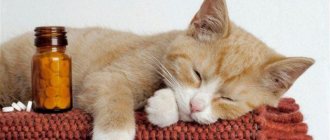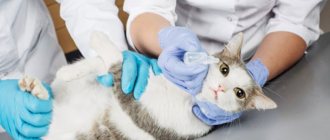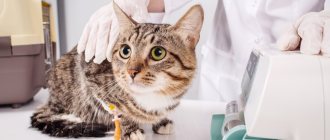Retention cysts (sialocele, mucocele) of cats are a rare pathological condition for this species of animal, in which there is an increased accumulation of saliva in the tissues surrounding the salivary gland and its ducts. The condition is also known as a salivary gland cyst, or salivary cyst. Salivary gland cysts are characterized by slow development. Often, pet owners notice them only when they reach a noticeable size.
In cats, as in other species of mammals, there are five salivary glands (Fig. 1), some of which are paired - located on each side of the head. The salivary glands function constantly, and during food intake they become more active, secreting a large amount of liquid and viscous saliva.
Rice. 1
First method
To help in this matter, a very convenient and easy-to-use device has been invented, called a piller or tablet dispenser. It allows you to significantly simplify this unpleasant procedure, as well as quickly and accurately give the kitten any tablet or capsule.
Using this device is very simple: the tablet is inserted into the rubber tip of the piller and placed in the animal’s open mouth (on the root of the tongue), then you need to press the piston and push out the medicine, close the mouth and stroke the throat, encouraging swallowing. Ready! Everything is quick and easy; you can purchase such a tool at any pet store.
Second method
You can also give the tablet to a kitten without using any equipment. If you have to do this for the first time, then it won’t hurt to have someone from your family participate in this process. The main task is to secure the pet well so that it does not have a chance to break free and run away.
You can place the kitten on a table or any higher place (so you don’t have to bend over) or sit on the floor on your lap. It is necessary to place the animal with its back to itself, so it will not be able to escape, you can also squeeze it with your knees (just not too tightly). Prepare the tablet in advance and hold it in your right hand.
The left hand lies on top of the pet’s head; you need to wrap two fingers around the muzzle on both sides and gently press behind the cheeks on the space between the jaws. This will force the cat to open its mouth; you need to lift its head up and place the tablet on the root of its tongue. Immediately close your mouth and make a few stroking movements along the throat from top to bottom to help swallow the tablet.
Do not rush to immediately release your pet; you need to open his mouth again and make sure that the tablet is actually swallowed. Among the mustachioed pets there are such cunning ones who can hide a pill in their cheek, and at the moment when the owner is not looking, they simply spit it out.
Difficulties in giving medications to a cat
It's hard to hold a cat.
The cat spits out the medicine.
The cat begins to drool profusely.
Here is an example: a cat does not resist much, but drools and partially spits out the medicine.
This is how a significant portion of cats will behave - and how can you give them something?
1:502 1:507
Treatment of cat diseases, prevention of worms, the need to take vitamins and other supplements - all this confronts us with the problem of how to give medicine to a cat. In some families, this procedure turns into a real quest: the cat is caught by seven people around the house, finally, they are grabbed and forced to open its mouth, but no such luck... As a result, the owners are bitten and scratched, but the result is not achieved...
1:1217 1:1222
In fact, it is quite possible to do without such stress for the animal and people, the main thing is to have the correct technique and act confidently.
1:1494 1:1499 1:81 2:585 2:590 2:903 2:908
- Not all veterinary medications can be mixed with food; some are taken strictly on an empty stomach. Products in special shells and capsules cannot be divided into parts and crushed, since they are intended for absorption only in the stomach and not in the oral cavity. Be sure to check with your veterinarian or instructions on how to take a recommended product before adding it to your food.
- Many products have an unpleasant taste, and cats have an excellent sense of smell and very sensitive taste buds. If you hide a pill inside a piece of meat, the animal, as a rule, masterfully manages to eat the delicacy and leave the medicine itself untouched.
- A finely crushed tablet or liquid mixed with wet food also does not always give the expected result. Even if your pet starts to eat, he may soon sense something is wrong and move away from the bowl. Thus, the owner cannot control how much of the drug is eaten, which will only complicate the matter.
To properly give medicine to a cat, it is better to act without tricks. How to do this depends on the prescribed dosage form. It is easier to give liquids and suspensions from a syringe, and tablets using tweezers or a “pill dispenser” (introducer).
2:3140
2:4
2:77 3:583 3:588
The problem of how to give a cat liquid medicine can be solved very simply: just buy an ordinary disposable syringe at the pharmacy and remove the needle from it. The syringe is calibrated in cubic centimeters. 1 cu. cm is equal to 1 ml.
3:979 3:982
Before manipulation, draw the required amount of liquid into the syringe in advance, and then secure the animal. It is better if an assistant does this, but if one is not available, you can swaddle the animal in a towel to protect yourself from sharp claws.
3:1436 3:1439
The tip of the syringe is carefully inserted into the side of the jaw - just behind the fang, where there is a fairly wide gap between the teeth. With your left hand, hold the cat's head slightly elevated, but not tilted upward.
3:1820
3:2
If the animal behaves calmly, then it is enough to clasp its neck with your palm from below and with an outstretched index finger lightly press the jaw upward, preventing the head from lowering.
3:358 3:361
The medicine from a syringe should be given slowly, in small portions, each time waiting for the cat to swallow, and lightly stroking its throat from top to bottom with the same index finger.
3:701 3:704
Make sure that the stream of liquid is directed strictly perpendicular to the jaw, and not into the throat, otherwise there is a high risk of moisture getting into the respiratory tract.
3:974 3:977
Sometimes during the procedure, the furry patient begins to drool. This is considered normal, but part of the active substance leaks out along with saliva, therefore, you have to slightly increase the dosage.
3:1353 3:1358 3:1442 4:1946 4:4
Many readers are concerned about the question of how to properly give medications to cats, for example, anti-worm medications in tablet form. It's a little more difficult, but nothing is impossible.
4:302 4:305
Often, owners simply do not know how to open the cat's mouth to give medicine, and act incorrectly. In fact, it is much easier to perform this action in relation to a cat than, for example, in relation to a person whose jaws do not protrude forward.
4:766 4:769
So, grab the animal’s head from behind with your hand, insert your thumb and forefinger between the lips at the corners of the jaw and lightly press on them. The cat's mouth will open slightly, and at this moment you need to quickly place the tablet on the root of the tongue - if you hit exactly this spot, the swallowing reflex will instantly work.
4:1380 4:1383
Immediately after this, lift the cat’s head and stroke its neck from top to bottom, without allowing it to open its mouth.
4:1574
4:2
For those who find this quite difficult or the cat actively resists, you can use an auxiliary tool - an introducer, or simply a “pill dispenser”. This device resembles a syringe with a plunger and a soft tip with several slits.
4:488 4:491
A tablet is placed inside the tip, and the piston pushes it into the animal’s mouth. To make it easier to swallow, you can add a little water to the tip along with the pill.
4:810 4:815 4:866 5:1370 5:1375
Do not forget to calm the cat throughout the procedure by talking affectionately to it. This works best if you imagine that in front of you is a very small child who does not yet speak, whom you persuade to eat another spoon “for dad” and “for mom.” At the same time, women instinctively raise their voices and develop gentle melodious intonations.
5:2016
5:2
Naturally, you can say whatever you want and even perform children’s sayings and nursery rhymes - practice shows that they have the same calming effect on cats as they do on babies.
5:329 5:332
Try not to be nervous yourself, behave calmly and confidently, and we hope our advice will help you with this.
5:538 5:543 5:615
If it’s easier for you to see once than to hear a hundred times, then watch these videos - practicing veterinarians demonstrate how to give your cat medicine yourself.
5:912 5:917 5:944 5:949 5:976 5:981 5:1021 5:1026 5:1047
Cats get sick, like all living beings, and there comes a time when your four-legged friend needs to be given medicine. The drug can be in the form of tablets, mixtures and injections. We’ll talk about how to properly give a pill to a cat.
Third method
If the animal behaves too aggressively, breaks out and bites, and you can’t give the kitten a pill, you can use one trick. To do this you will need a towel, or blanket, or any thick fabric. A kitten or adult cat is wrapped in it so that only the head remains outside. This bundle can be placed on your lap or on your left hand, so that the muzzle is facing the owner.
Of course, all this time the kitten will be trying to free itself from captivity, so everything needs to be done quickly. The next task is to open the pet's mouth. We lift his head with one hand and press with our finger in the place behind the fangs - this will force him to open his mouth. Now you need to quickly place the tablet there, preferably further and deeper - at the root of the tongue. We make several stroking movements on the throat and check whether the tablet is swallowed or not.
This method is guaranteed to be very disliked by your pet, because cats hate it when something is done to them against their will. On the other hand, this way you can quickly and conveniently give any pill, and also protect yourself from the sharp claws of an animal. Regardless of which method is chosen to give the pill to a kitten or cat, it is not always possible to do it the first time. Most often, the second or third attempt ends successfully. In this, as in any matter, practice and skill are needed.
Don't forget to praise the kitten, caress it and treat it with something tasty (if this is not contraindicated!). Do this every time after this procedure to develop a pleasant association in your pet and simplify the whole process in the future.
Cats get sick, just like people, and the veterinarian prescribes medications for them. And to prevent various diseases, animals are given tablets. Does the thought of giving your cat a pill make you feel bad? You can't just shove it into the mouth of a stubborn animal with a terrible character. Don't worry, we'll tell you how to easily give the pill to your pet.
Precautionary measures
To avoid injury during treatment, the owner must follow the following safety rules:
- It is advisable for two people to host the event.
- Secure the cat with a blanket, towel, or diaper.
- Prepare medications in advance and in another room. Otherwise, the cat will immediately feel that it is for him and will hide.
- Try to reduce the time of the procedure to a minimum. The longer an animal experiences fear, the more aggressive it becomes.
Cats are capricious and are unlikely to agree to take medication voluntarily. Therefore, it is recommended to accustom them to the procedure from childhood, accompanied by encouragement and affection.
Every cat has to take medication at least once a year before routine vaccinations. Getting an animal to eat a pill is not an easy task. Cats are acutely aware of any dirty tricks; they hide and refuse food if it contains any unpleasant impurities.
It is important for pet owners to know how to give their cat liquid medicine from a syringe or in dry form and to be able to resort to certain tricks.
How to give a cat a tablet - mix it into food
Ask your veterinarian if you can mix the tablet into your food? Bitters and gelatin-coated preparations are not added to animal food. Another question for the veterinarian: can the tablet be dissolved in water? This makes the procedure easier. If you can give the medicine with food, your steps are as follows:
- Crush the tablet and mix the powder with your cat treat. If it is a capsule, open it and pour the powder into the food, then stir. Open the capsule only with the permission of the veterinarian or if this is allowed in the instructions. But the cat may smell the medicine and not eat the food;
- smear the cat’s nose with a mixture of sour cream and crushed tablets. The cat will lick this mixture;
- Place a small tablet in a piece of sausage or other cat favorite product. But a cat can eat the sausage, but the medicine will remain.
The above method can only work if the tablet is small and without a strong odor. Cats have a stronger sense of smell than humans. The animal will recognize the filling of the product and refuse to eat it.
How to give a cat a pill - a radical method
If you need to give the whole tablet, your steps are as follows:
- take the cat in your arms, stroke it, calm it down;
- press the relaxed pet to your lap;
- simultaneously hold the cat’s body with one hand and his head with your palm;
- open the pet's mouth with the thumb of the same hand;
- Place the tablet with your free hand in the cat's mouth. Place it on the side or at the root of your tongue;
- close the animal's jaw and wait for the pet to swallow the pill.
Calm down or simply release the poor sufferer. It's good if you have an assistant who holds the cat, and you put the medicine in his mouth. You can give your cat tablets that can be diluted with water using a syringe. First remove the needle from the syringe.
How to give a cat a pill - use a blanket
What to do if your pet breaks out of your hands and cannot be restrained? Use a blanket or thick blanket to prevent your cat from scratching you. Catch the cat and wrap him tightly in a blanket. One of his heads should be visible from the blanket. Take the cat in your arms, and then everything goes according to the scheme described in the second paragraph. Do not immediately wrap your pet in a blanket. Place it on the sofa or windowsill, pet it and talk to the animal.
- Give a stubborn cat the pill in neutral territory, not in places that are attractive to her. For example, take it out into the hallway or into the bathroom;
- do not shout at a frightened pet. He's already scared;
- Make sure your cat swallows the tablet. She will lick her lips if the medicine is eaten. Some cunning people hide the pill in their mouth, and when they are released, they spit it out on the floor;
- Praise the cat for eating the pill and treat it to something tasty. This will calm the pet and he may remember that after a bitter pill he is given something tasty.
Remember that the success of this task depends on the character of the cat. There are calm animals and they take the pill without problems. And there are cats with bad temperaments and you will have to work hard to get the cat to swallow the medicine. If all else fails, take your pet to the veterinarian, he will certainly give the cat a pill.
At first glance, it seems that there is nothing simpler than giving a cat a pill. In fact, this is far from a simple procedure, since cats, thanks to their love of freedom, absolutely do not tolerate being manipulated against their will. In order to give the cat medicine, you will have to hold it tightly. The first thing he will do at this moment is try to run away quickly, because cats do not tolerate being held tightly.
There are many ways to properly give your pet this ill-fated pill. Their advantage is not only that the medicine will reach its target, but also in the absence of both the cat and its owner.
Mix with food
This method can be used after first finding out whether the positive effect of taking the tablet will disappear after mixing. This can be read in the instructions for the medicine.
- The tablet must be pre-crushed.
- Mix with your cat’s favorite food, taken in small quantities.
- Make sure that the food is completely eaten. If the cat did not eat everything, then we can say with confidence that the required dose did not enter the animal’s body.
- You can try dividing the tablet into two parts and fixing it either in a sausage or in boiled minced meat. It is important that the lined pieces are small. This is required so that the cat does not chew them, but swallows them whole.
Using butter
Even with a strong desire, the cat will not be able to spit out the tablet. Thanks to the butter, it slips into the throat.
- If the tablet is small, then it needs to be dipped in butter.
- Place the cat as close to the root of the tongue as possible.
- If the tablet is large, it must first be divided into parts.
Basic scheme
1. Prepare a syringe with medicine.
The liquid medicine is given in a syringe without a needle.
The syringe is usually calibrated in milliliters. Remember that 1 milliliter is 1 cubic centimeter. A teaspoon will contain about 5 milliliters of liquid.
2. Fix the cat.
You need to take the cat on your lap so that she cannot scratch you. You can wrap the cat in a blanket or towel and open its mouth slightly. To do this, place your thumb and thumb behind the fangs and push the cat's jaw apart.
It is important that the cat's head is raised up when swallowing, otherwise she will spit out the medicine by shaking her head. The head should not be thrown back, otherwise the cat may choke. Fixation of cats
3. We give medicine.
Then place the syringe in the corner of the cat's mouth behind the fang.
Slowly pour the contents of the syringe into the side of your throat. There is no need to rush - the animal may choke. Inject no more than a milliliter of solution at a time, about a quarter of a teaspoon, and allow the cat to swallow in between to prevent it from choking.
When the medicine in the syringe runs out, close your cat's mouth. Wait, she must swallow everything, otherwise the cat may simply spit out the medicine. If after this you remain unharmed, you can stroke the cat's neck towards the esophagus. This stroking helps to swallow the medicine.
4. Calm the cat.
If possible, after the procedure the cat should be calmed, petted and given treats.
The main ways to give deworming tablets to a cat
Method 1
Irritation of the root of a cat's tongue causes a swallowing reflex.
- You need to open the animal's mouth.
- The medicine for worms should be placed as close to the root of the tongue as possible.
- Then close your pet’s mouth and hold it for a few seconds.
- It is important not to press on the base of the tongue, as this may cause backfire.
Method 2
To give your cat deworming medicine, you need to sit comfortably on your knees. Place the animal with its back to itself, so that it does not have the physical ability to escape.
With one hand, tilt the cat's head up, lightly pressing on the lower jaw. The cat will open its mouth. All that remains is to push the medicine as close to the root of the tongue as possible.
Having closed the mouth, be sure to make stroking movements along the pet’s throat from top to bottom. This way the swallowing movement is stimulated. After this, it is worth making sure that he really swallowed the anthelmintic.
Method 3
Before you start giving, you need to sit him on your lap facing you. A distraction will be the stroking movements of the abdomen. At this time, the pet relaxes, and the desire to slip out of the owner’s hands disappears.
With your left hand, the cat's head is thrown back, at the same time the jaw is unclenched by applying firm pressure on the base of the jaw. With your right hand, the tablet is pushed closer to the root of the tongue. To stimulate the swallowing reflex, you need to carry out movements directed from top to bottom along the animal’s throat. After the cat makes a swallowing movement, it is necessary to check for the presence of the tablet in the mouth.
You need to be wary of its strong hind legs, which it can use to rest on its owner’s stomach. You also need to carry out manipulations as quickly as possible so that she does not have the desire to kick with her hind legs.
Method 4
Using a peeler. A piller is a design that looks like a syringe. With its help, you can easily and quickly give your cat medicine. To use this device to feed a deworming tablet, you need to:
- Place the medicine securely in the rubber tip.
- After opening the cat's mouth, place the tip with the medicine as close to the root of the tongue as possible.
- By confidently pressing the piller piston, push the drug into the animal’s mouth.
- Get the peeler.
- Close the cat's mouth.
- Stimulate the swallowing reflex by stroking the throat.
Method 5
If there is no original device at home, and the drug against worms needs to be introduced into the body, the faster the better, then it can be easily done at home.
- Take a syringe. The tablet must match the diameter of the syringe circumference. Typically a 2 ml syringe is used.
- Carefully cut off the edge, preferably without jagged edges.
- Place the medicine inside the syringe.
- Open the cat’s mouth and, placing the “piller” closer to the root of the tongue, squeeze the medicine into his mouth.
Etiology of damage to the salivary glands:
- Trauma – blunt or penetrating wounds. Iatrogenic injuries (received during the performance of any diagnostic procedures) are possible.
- Foreign bodies (accidentally eating sharp and hard blades of grass and leaves can lead to blockage of the ducts of the parotid salivary gland).
- Bacterial and viral infections (eg leukemia).
- Formation of calculi (stones) in the ducts of the salivary glands.
- Immune-mediated diseases.
- Neoplasia (tumors).
- Idiopathic (unknown) etiology.
- Breed predisposition in cats is uncharacteristic.
- Age predisposition: mostly young animals are affected; older animals are more likely to have tumors.
The main danger of the disease lies in the neglect of the process, which leads to indigestion and perverted appetite, but the most terrible consequence may be a cancerous tumor, which often develops in the tissues surrounding the affected salivary gland as a result of the constant irritating effect of saliva.
How to give the suspension
Giving a suspension to a cat is no easier than giving tablets, since in no case does it want to swallow what a caring owner offers it. She begins to salivate excessively. On the face you get a whole beard from the medicine.
- To give your cat or kitten a suspension, you can try mixing it with your pet’s favorite food: pate, minced meat, sour cream. This must be done with a small amount of food in order to accurately control the dose of the drug eaten.
- Everyone knows that cats are very clean animals. The anti-worm suspension can be spread on your pet’s paws. He will diligently begin to lick them. This way he will lick the entire dose of the drug and save both himself and the owner’s nerves.
How to give anthelmintics to a kitten
A kitten can only be given anti-worm medication from three weeks of age. After the first deworming, it is necessary to repeat the procedure 10 days later.
As a rule, it is easier for a kitten to carry out such activities than for an adult animal.
- The medicine in tablet form can be crushed to form a powder, which should be carefully poured from a piece of paper into the baby’s mouth. It is better to keep the kitten on your lap while lying on its back.
- Second option: the tablet is diluted with a small amount of water. Give from an insulin syringe, from which the needle must first be removed.
- It is easier to administer the suspension to a kitten together. One carefully holds the baby so that he does not twitch. And the second, raising his upper lip, gradually injects the medicine from the side. Then you need to stroke the animal’s neck from top to bottom.
Additional ideas
- The animal should not be wrapped in a blanket. You can try to do it without using force. You can put it on the table and turn it away from you. The main thing is not to show the cat the medicine in advance.
- Before giving your cat deworming medicine, you need to prepare everything first. The tablet must be removed from the blister and, if necessary, crushed. When administering the drug, every second will count.
- In order to properly open your pet's mouth, you need to insert your finger between the front teeth. Then firmly but painlessly press on the lower jaw.
- To make the cat more flexible, you can hold it by the withers.
- Never let your cat go until she licks her lips. If she licks her lips, then this is a sign that she has swallowed the medicine.
- Deworming tablets, which have an extremely unpleasant odor and taste, can be kept in the refrigerator before use. Cold can reduce odor and eliminate bitterness at least for the duration of taking the product.
Safety rules for hosts
What measures should the owner take to avoid injury during the treatment of the cat? You can make such procedures safer by observing the following rules:
- Do not feed the tablets to cats alone. The risk of injury is significantly reduced if different people give medications and hold the pet.
- Wear gloves made of thick material. They will be useful to the one who will keep the animal.
- Use towels or blankets to securely hold the cat. Sometimes even calm and balanced pets are capable of aggression if they sense danger, so additional restraint is simply necessary.
- It is better to prepare medications and remove tablets from the package in advance and not in the room where the pet is.
- Do not give medicine to your cat if it is under stress. Before the procedure, you need to calm her down and stroke her so that she feels comfortable.
- Reduce the duration of manipulation to a minimum. The longer an animal feels fear, the greater the likelihood of aggression.
- Prepare hydrogen peroxide to treat wounds if the pet does break out and scratch its owners.
Features of cat behavior
Normal behavior for a cat is to refuse medications. If a cat actively resists attempts to feed it tablets, then this indicates its health. Passive behavior and calm use of medicine are a sign of illness.
If the owner has little experience and finds it difficult to feed the cat a tablet, then it can be replaced with drops, a suspension or even an injection. At the pharmacy, you can ask whether the medicine prescribed for your pet is available in other forms.
The younger the animal, the easier it is to give medicine. It seems that it will be more difficult to get a pill into their small mouth, but kittens are more flexible than adult animals.
If a cat is regularly given anthelmintic drugs from infancy, then with an adult animal there will be less hassle in this matter in the future.
Emotional mood or how to tame a cat
A cat that feels threatened chooses different behavioral tactics:
- Scratch, bite, resist.
- Pretend to be dead or sick.
- Try to run and hide in a distant place, inaccessible to humans.
The owner at this moment needs to be calm and confident. All manipulations of administering medications cause stress in the animal. In addition, it senses the person’s mood. There is no need to shout or scold the ward. The pet must understand that its owner is in charge in the situation. Therefore, breeders recommend that you immediately take a dominant position, sitting on your knees above the cat and carry out manipulations.
The view of animal psychologists
Animal psychologists say that the cat must be given the opportunity to swallow the medicine on its own. Many preparations contain herbs that the animal may well like. When it goes away, you can use the methods described below.
If, nevertheless, the owner has no other choice but to use force, then the person’s actions must be accurate, confident and well-functioning. The cat must be sure that the person is stronger than her, and he knows what he is doing. A calm owner will convey his calmness to the pet. If he is stressed, then even before the unpleasant procedure begins, his anxiety will be transmitted to the pet.
Animal psychology claims that a cat has 3 types of actions during danger:
- Resistance. She actively resists the process: she bites and scratches.
- If the first phase does not bring the expected result to the animal, then it proceeds to the second phase: the cat freezes, pretends to be dead, lifeless and sick.
- The next phase is running away.
The medicine should be given in the second phase of the animal’s behavior. During this period, the cat will allow its mouth to open. After he has been given medicines, you need to caress your pet and offer him something tasty. All activities must be carried out in a good mood; under no circumstances should you raise your voice at the animal. A cat understands perfectly well when they love it and do not mean harm to it.
Of course, you can turn to a veterinarian for help; he can give the cat an anti-worm tablet in his office. But all cat owners should have the ability to properly feed an animal an anthelmintic.
Pets, like people, do not like to get sick. But they like taking medications even less. Therefore, every owner who has ever treated their pet knows how difficult it is to give a pill to a dog or cat. Moreover, cats, due to their waywardness, resist treatment more strongly than other animals. Sometimes, in order to give a cat a pill, you have to involve all the household members who, with treats, persuasion, and sometimes using force, try to force the cat to eat the pill. If you usually do it exactly the same way, you are, at a minimum, wrong.
There are much more effective and simpler ways to feed a pill to a cat so that he swallows and does not spit out the medicine. The main thing is that they allow you to give the cat medicine quickly and without violence, which means that it is stress-free and makes subsequent treatment easier. You understand that the cat remembers unpleasant emotions associated with your actions. In order not to form a negative conditioned reflex to the procedure, you need to know how to give the pill to the cat correctly and painlessly. And it's easier than it seems.
Tablets for cats: how and why to give tablets to a cat?
If your cat doesn’t want to swallow the pill, congratulations, your cat is behaving absolutely adequately and correctly from her own, cat’s point of view! It is much worse if the cat swallows medications, including pills, without resistance. Apathy is a much more alarming sign of illness than active resistance to your attempts to feed a pill to your cat. However, you shouldn’t rejoice at disobedience if the pill remains uneaten. One way or another, you will have to force the cat to swallow the pill, the only question is how quickly this will happen and how many scratches will remain on your body.
If it is necessary to give your cat medicine, they often resort to tricks:
- Firstly, whenever possible, tablets are replaced with drops or injections. Ask your veterinarian to see if the prescribed medication is also available in liquid form for oral use, that is, in the form of drops that are easy to give to your cat. Injections are more effective than tablets, but are only used in extreme cases.
- Secondly, paradoxically, the older the cat, the more difficult it is to give him medicine. Although kittens have small mouths that make it difficult to put a pill into, they are usually more flexible and resist less. Therefore, try to accustom your kitten to taking medications “from infancy”, then in the future it will be much easier for you to give the pill to an adult cat.
In any case, it is important not to injure the animal either physically or mentally, and to avoid injury yourself.
A veterinarian is best able to handle this task - if possible, ask him to administer the pills to the cat in his office. If this is not possible, you will have to give the pills to your cat yourself at home. Effective ways to give your cat a pill
Many tablets have a bitter taste, but if you cannot give your cat an injection instead of a tablet, then you will have no choice but to adapt to the habits of a particular animal and find the best way to give the cat a tablet. Fortunately, many generations of breeders and their pets have developed several truly effective methods:
- Sweeten the pill.
And literally: mix a small tablet (the easiest way to do this is with homeopathic pill-balls) with food that the cat likes and will probably eat. True, it is possible that she will smell the medicine and act like the dog from the old Soviet comedy: she will eat everything except the pill itself. But your task, as the owner, is to choose and disguise the treat correctly in order to still achieve your goal. - Look at the root.
In this case we are talking about the root of the cat's tongue, the stimulation of which causes a swallowing reflex. With one hand, open your pet's mouth, and with the other, place the tablet as deep as possible on the base of the tongue, but do not press so as not to provoke a burp. Once the tablet is in the right place, close the cat's mouth and hold the jaws for a few seconds. This is enough for the cat to reflexively swallow the pill. - Slippery moment.
You can make the task easier for yourself and your cat if you lubricate the tablet with something slippery: butter, soft cheese, lard, etc. After this, place the tablet on the cat's tongue as described above. A lubricated tablet will easily slip into the throat, and the cat itself will not want to spit out the tasty morsel. - Ticklish position.
The swallowing reflex is associated not only with the tongue, but also with the nasopharynx. When you place the tablet on your cat's tongue and close its mouth, blow on its nose. You need to blow lightly, but sharply, into the nostril area. The second option is to slightly tickle the outside of the cat’s throat with your fingertip and scratch its neck. - Fine work.
Large tablets are difficult to swallow even for people, let alone animals. But the medicine will not change its properties if you break the tablet into two or even four parts and give them to the cat one at a time. You can even crush the tablet into powder using a pestle or two tablespoons. The crushed medicine is poured into the cat's mouth or mixed with food. - Just no hands
- let the cat lick the medicine herself instead. To do this, mix the powdered tablet with something liquid and/or sticky like broth, pate, sour cream, etc. Dip the cat's paws into this mixture and make sure that the clean animal thoroughly licks the medicine. Carried away by washing itself, the cat simply will not notice the drug. As an option, apply the mixture not to your paws, but to the tip of your nose.
If all these tricks do not work, and the cat refuses to take the pill, you will have to resort to a last resort and immobilize him with a blanket or towel.
This method is used when it is necessary to give an injection to a cat with a character, but it is also suitable for a tablet. The main thing is to secure all the paws and prevent the cat from escaping, and only then open his mouth and put a tablet on his tongue. It is possible that you will need the help of a second person, especially if the cat is large and nervous. Useful tips on how to give your cat a pill more easily
Even if you have already had to give pills to a cat more than once and you know how to force the cat to swallow a pill without anyone else, you may find additional ideas useful: All owners develop their own ways of giving a pill to a cat, because all animals have different characters and habits. Perhaps there is only one general rule: do not forget to praise your pet for eating the medicine and treat him with something very tasty after the pill. On the one hand, this will calm the cat and relieve stress caused by the violence that occurred. On the other hand, there is a chance to form a positive conditioned reflex, so that next time it will be easier to give the cat a pill. Health to your pets, and to you mutual understanding with them!
Cats, by their nature, are creatures that are difficult to tolerate treatment. Owners of four-legged friends know firsthand that it is not easy to get your pet to swallow medicine. The cat family resists treatment more than other animals. In most cases, owners have to ask relatives or friends for help in order for the procedure to be effective. In fact, giving a cat a deworming pill is much easier than it might seem at first glance.
The essence of the procedure is not to cause any moral or physical harm to the animal. Experienced breeders have developed several effective ways to carry out the procedure. If you are still afraid of deworming yourself, contact your veterinarian.
Method No. 1. Mix the tablet with meat
The easiest way is to crush the tablet and mix it with your cat’s favorite treat. This way the animal will swallow the pill and not pay attention to the contents of the medicine. It is possible that the cat will sense the presence of the pill and completely refuse to eat.
This does not change the task; try to mix the drug so that the pet does not feel it. Many housewives prefer to mix a cutlet or sausage with an anthelmintic, use this option.
Method No. 2. Trigger the swallowing reflex
We are talking about the root of the animal's tongue. As a result of the tablet’s effect on this area, the pet reflexively swallows the drug. To carry out the procedure correctly, take your pet in your arms and secure its body well. Open your pet's mouth, then place the medicine on the root of the tongue.
At the end of the procedure, gently squeeze the mouth and wait a while for the animal’s swallowing reflex to work. The easiest way to carry out manipulations is to first break the anthelmintic drug into 2-4 parts, and then feed them to the cat one by one.
Method number 3. Explore the list of "tricky" products
There are a number of certain foods that overshadow the bitter taste of the medicine. Use chicken/beef liver pate, processed cheese, and butter. Mash the tablet into crumbs using two tablespoons, mix with one of the listed ingredients.
Place the medicine in the pet's mouth and induce a swallowing reflex (the method is described in method No. 2). The animal will think that you have given it a treat; as a result, there should be no resistance. However, there are certain breeds that have a heightened sense of smell.
Method number 4. Target your sinuses
The swallowing reflex is associated with both the tongue and the nasopharynx. After placing the tablet in your pet's mouth, close it and blow lightly into the nose. As a result of such manipulations, the cat will swallow the anthelmintic drug by inertia.
To make the procedure more effective, you can grind the tablet into powder and dilute it with a small amount of water. After this, pour the medicine onto the root of the tongue, close the pet’s mouth and scratch the neck (throat). Your actions will provoke swallowing.
Method No. 5. Add the tablet to the sour cream
You can achieve a “peaceful” solution to the problem by taking medication. Grind the tablet to a powder and mix with high-fat sour cream (preferably homemade, fat content from 25%).
After this, smear your pet's paws or the tip of his nose. Carry out such manipulations in order to provoke your pet to start washing itself. He will lick the medicine without noticing the catch. Butter or other dairy products are used in a similar way.
Method number 6. Force feed the medicine
There are often cases when a cat flatly refuses to swallow the pill. If the above methods turned out to be ineffective, proceed to operation “X”. Prepare a blanket or blanket and wrap your pet completely. Only the cat's head should stick out, this way you will avoid scratching and kicking.
Most often, veterinarians use this method when they want to vaccinate obstinate cats. Secure the animal's paws so that it cannot escape, then put the tablet in its mouth. You can grind the drug into powder and mix it with sausage, butter and other tasty foods. Also, the medicine can be fed in its original state.
As mentioned earlier, many cats have a negative attitude towards deworming prevention. To carry out manipulations without damaging the pet’s psyche, mix the powdered tablet with the animal’s favorite treat. Choose high-quality medications that have minimal side effects. Keep a notebook and note down each procedure performed. Worm your cat 2 times a year at equal intervals.
What should you do if your cat struggles, resists, and spits out the medicine?
If the cat actively resists, the owner is not always able to give him deworming medicine or another drug. After repeated feeding attempts, the tablet still ends up on the floor, the pet scratches, resists, bites, and spits out the medicine. In such situations, you can seek help from a veterinarian or take advice from specialists. You can watch training videos on how to properly restrain an animal and give medicine.
How to restrain a four-legged patient?
It is sometimes difficult to restrain a cat on your own, so experts recommend doing it together with a family member. One person holds the pet, and the second wraps it tightly in a blanket, blanket, towel or other material. The assistant then holds the wrapped cat while the owner feeds the pill to it without fear of resistance.
Another method of fixation also involves the participation of two people. The assistant must take the animal by the withers and hold its paws with the other hand. In this position, the cat will not be able to escape. The owner opens his pet's mouth and places the tablet on the root of the tongue.
How to get a cat to swallow the drug?
Just because a tablet is in a cat's mouth does not mean that he will swallow it. Many pets keep bitter pills in their mouths until they are released. Once free, they spit out the pills. If the owner notices that the medicine has not been eaten, the procedure is repeated. However, sometimes pets manage to get rid of the medicine unnoticed, which complicates the situation, especially when the drug is given not for prevention, but for therapeutic purposes.
To ensure that the cat swallows the medicine after it gets into her mouth, you need to place the tablet on the root of the tongue, and then hold the stubborn patient's jaws closed for a few seconds. In this case, you can try to evoke a swallowing reflex by blowing into her nose or stroking her neck from top to bottom. After the procedure, you should not let the cat go without examining the oral cavity; you need to make sure that there are no tablets in it.











